Add Winter Interest to Southwest Gardens with Euphorbias
The unique shapes and colors of euphorbias add a touch of drama to drought-tolerant landscapes. There are hundreds of species of this genus of plants, most that resemble something out of a Dr. Seuss book. These are succulents that do well with little attention and do well when planted in the ground or containers, although they do require well-drained soil. All can grow in zone 9 gardens (includes Central Arizona), although a few will need protection from freezing temperatures. Let’s take a look at seven species of euphorbia that will add welcome interest in winter, as well as throughout the year in low desert gardens.
Caution: All of these euphorbias have a milky sap that is irritating to the skin and eyes, and toxic if ingested. Use care when handling or pruning.
Firesticks (Euphorbia tirucalli ‘Sticks on Fire’) Arguably the most colorful of the euphorbias we are profiling, Firesticks has thin succulent stems that are bright orange at the tips, fading to green at the base. They look much like a plant that you would find under the sea and can be maintained at 3 to 10 feet in height, although they can grow taller. Plant in full sun.
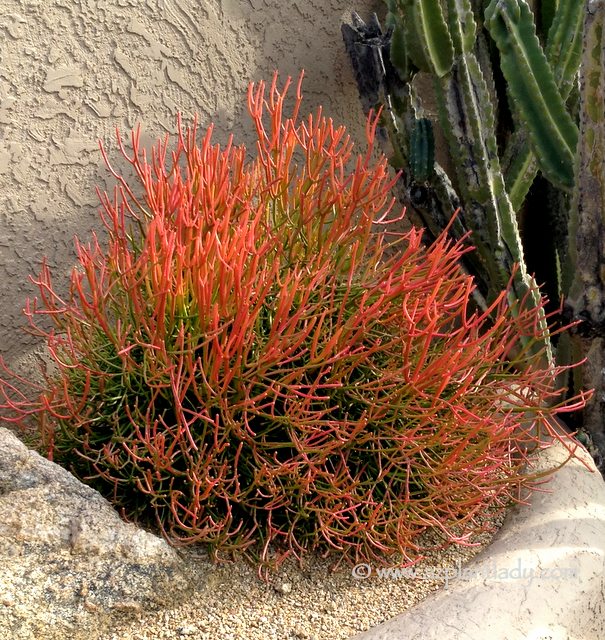
Crown of Thorns (Euphorbia milii) – The flowers of this shrubby euphorbia add a bright splash of color and can occur off and on throughout the year. Its thorny stems are covered with green leaves where colorful brachts are produced that surround tiny flowers. Available in red, pink, and pale yellow colors, Crown of Thorns will grow 2 – 3 feet tall. Plant in an area that receives morning sun or filtered shade and protect from freezing temperatures.
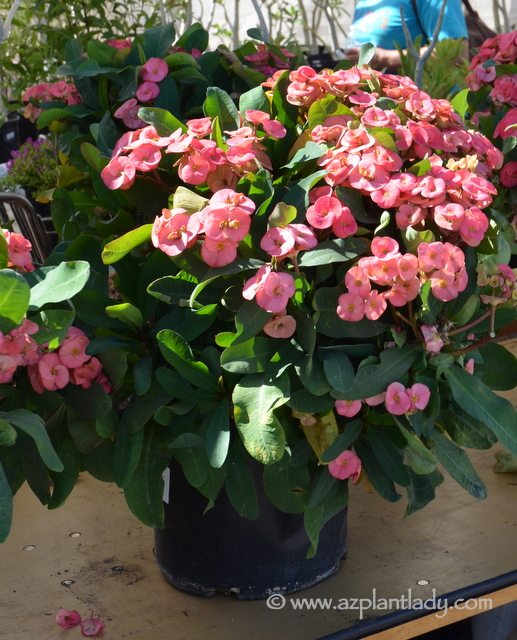
Moroccan Mound (Euphorbia resinifera) – Succulent stems create a nicely mounded clump and gradually increase in size as new stems are formed causing this euphorbia to resemble a low-growing cactus. Each stem has four margins that have tiny thorns. They look great when planted next to boulders or in containers. Plant in full sun and allow room for them to grow 4 to 5 feet wide.
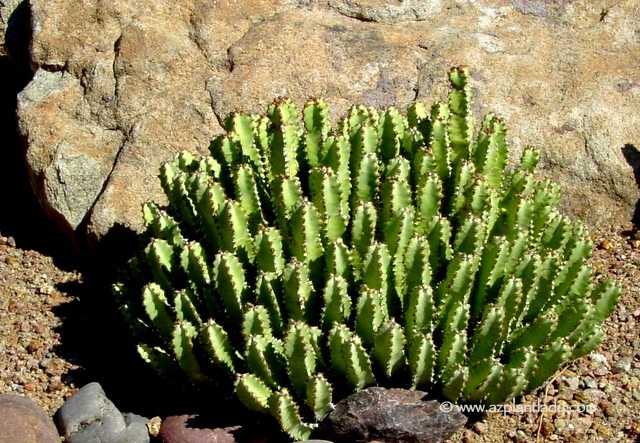
Gopher Plant (Euphorbia rigida) – Another flowering euphorbia, blue-gray stems are transformed by the appearance of chartreuse flowers in late winter and on into spring, adding welcome color to cool-season gardens. When not in flower, the swirled arrangement of the leaves around the stems add a nice texture to the landscape. Hardy to 0 degrees F., plant in groups of 3 next to boulders in full sun.
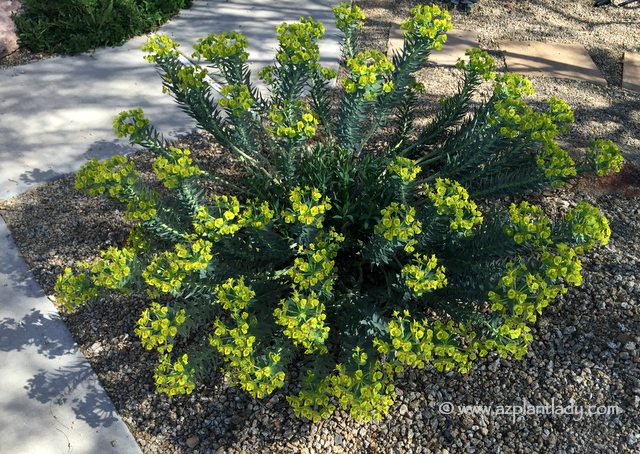
Candelilla (Euphorbia antisyphilitica) – Closely packed, thin, upright stems add fine texture contrast to the drought-tolerant garden. This euphorbia easily handles the cold and thrives in full sun and reflected heat. Its shape makes it a good option for contemporary landscapes when planted in straight or staggered rows. Tiny pale pink flowers appear in spring for several days. Hardy to 10 degrees F., plant in full sun where they will reach 1 to 2 feet tall and 2 to 3 feet wide.
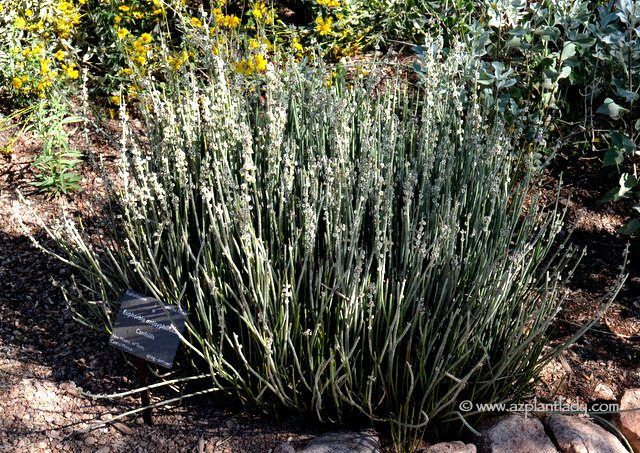
African Milk Tree (Euphorbia trigona) – This columnar euphorbia is made up of clusters of upright, succulent stems, resembling the popular shape of many cacti species and will reach 3 to 9 feet tall. Along the side of each stem are small thorns where leaves grow. It does require some extra care in desert gardens and should be protected when temperatures dip below 33 degrees F. Plant in filtered shade.
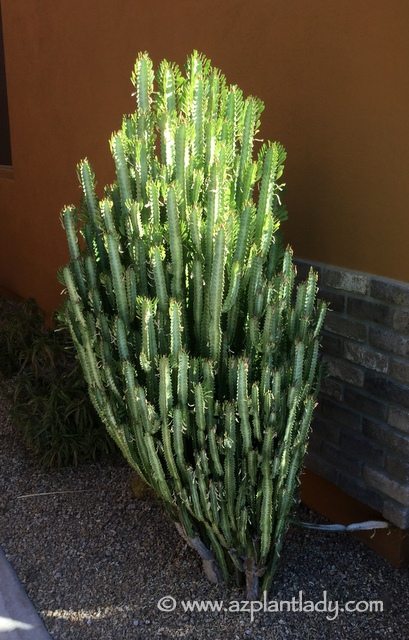
Pencil Milk Bush (Euphorbia mauritanica) – A newer arrival to the desert plant palette, Pencil Milk Bush has a lovely mounded growth habit with small succulent stems that bear little yellow flowers in the cool-season. It looks great in a natural setting, planted next to boulders or in a more contemporary design arranged in rows. Plant in full sun or filtered shade where it will grow 2 feet tall and 2 to 3 feet wide.
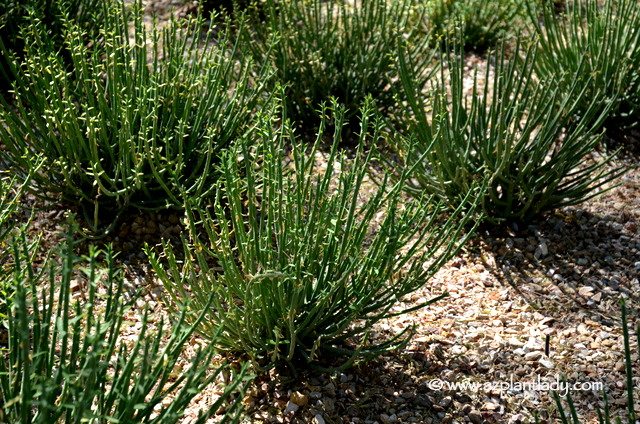
Whichever euphorbia you choose for your landscape, it’s guaranteed to add texture, color, and beauty in winter and beyond.
Did you know that up to 70 percent of water use is outdoors? That’s why we love desert plants and feature them each month. It’s still a great time to plant non-tropical plants in your landscape, and you can learn more about Euphorbias and other plants on our Arizona Low-Water-Use Plants page. Visit our page on Choosing and Planting Low Water-Use Plants for tips on plant selection and how to plant properly. Also, be sure to read through all of our featured Plant of the Month blogs!
From time to time, Water – Use It Wisely features guest bloggers who write about topics related to water and water conservation. Noelle Johnson is an urban horticulturist, Certified Arborist and freelance garden-writer who helps people create beautiful, low-maintenance gardens through helpful advice on her blog www.azplantlady.com. She is passionate about teaching people about the amazing desert plants that thrive in our landscapes.

